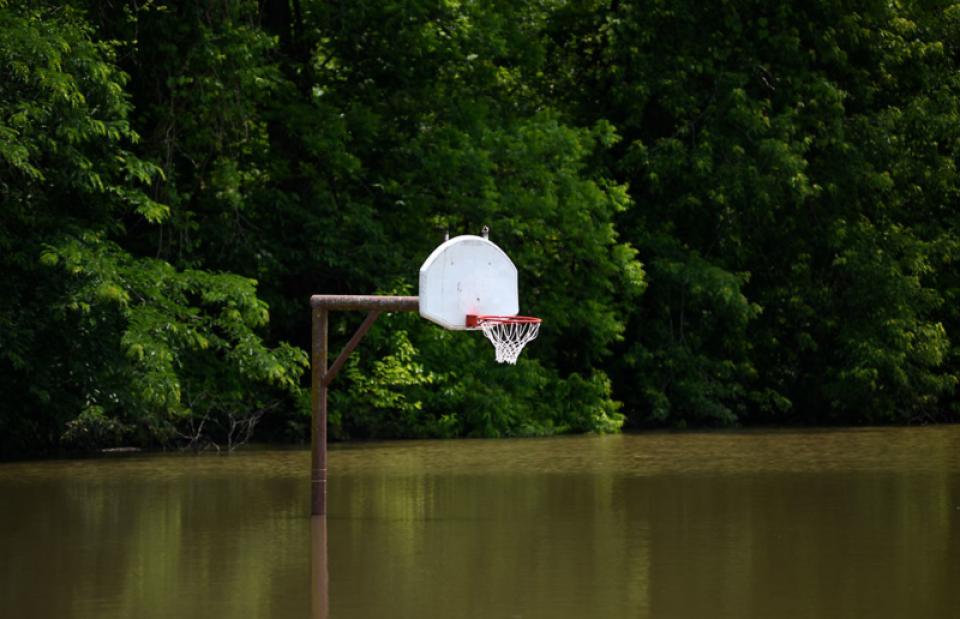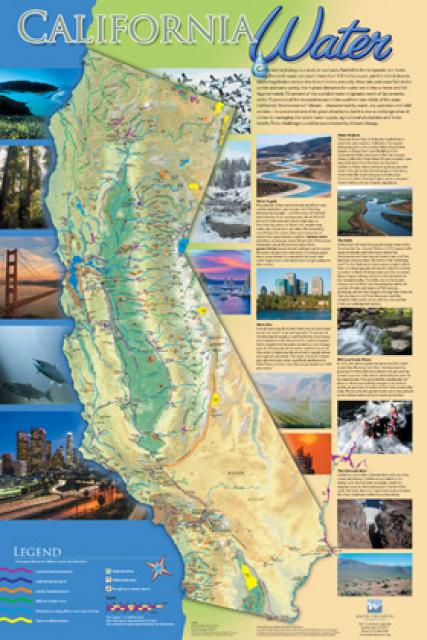California Project WET Gazette
Winter 2025
Basketballs & Streamflow Estimation
 Dispelling misconceptions is often hard to accomplish and discovering you unwittingly helped spread an erroneous perception is downright gut-wrenching. Case in point: Using a basketball to help people visualize one cubic foot in estimating the flow of water in a stream.
Dispelling misconceptions is often hard to accomplish and discovering you unwittingly helped spread an erroneous perception is downright gut-wrenching. Case in point: Using a basketball to help people visualize one cubic foot in estimating the flow of water in a stream.
Jay Lund, a retired UC Davis professor of civil and environmental engineering, attempted to deflate the basketball imagery in a March 2023 California WaterBlog post demonstrating the analogy is not mathematically correct.
Cubic foot per second – or CFS – is a hydrological term for a volume of water equal to 7.48 gallons flowing past a given point each second. CFS is commonly used to gage streamflow in the United States. But visualizing a one cubic foot box is not so easy for most people. Basketballs on the other hand are familiar, and someone in the past got the idea of having people think of cubic feet and basketballs.
The analogy seemed like a slam dunk. Prominent agencies like the US Army Corps of Engineers, Bureau of Reclamation, the National Park Service have adopted the basketball conversion for laypersons and the ball comparison is a favorite among river rafting guides and other businesses catering to outdoor enthusiasts.
 I’ve often used this analogy myself while leading the Project WET activities “Blue River” and “A Snapshot in Time,” and in practice while leading a stream study as part of “Macroinvertebrate Mayhem” or “Water Quality? Ask the Bugs!”
I’ve often used this analogy myself while leading the Project WET activities “Blue River” and “A Snapshot in Time,” and in practice while leading a stream study as part of “Macroinvertebrate Mayhem” or “Water Quality? Ask the Bugs!”
The volume of the basketball measured for the WaterBlog article was actually one-fourth of a cubic foot. Basketballs do come in different sizes, but even accounting for this variable wouldn’t change the calculation much.
The problem is the basketball analogy has worked quite well in practice with learners of all ages coming up with good rim shot estimates close to actual USGS stream gage values – Multiplying by 4 as suggested in the WaterBlog article would turns these into complete air balls.
 Why has the analogy endured despite the mathematics? Are people just generally bad at estimating volumes? Or are estimations just that – a rough approximation to help people visually grasp a cubic foot of water The Army Corps article takes this approach in noting, “A cubic foot of water can be visualized by the amount of water stored in a 12-inch cube. The cube would be large enough to hold a standard basketball with lots of room to spare.”
Why has the analogy endured despite the mathematics? Are people just generally bad at estimating volumes? Or are estimations just that – a rough approximation to help people visually grasp a cubic foot of water The Army Corps article takes this approach in noting, “A cubic foot of water can be visualized by the amount of water stored in a 12-inch cube. The cube would be large enough to hold a standard basketball with lots of room to spare.”
Why does this discussion matter? Streamflow is a vital part of the water cycle that continually returns water from land to the ocean, altering the landscape it flows through while redistributing eroded sediments and nutrients in the process.
This continual flow of water sustains natural communities and ecosystems that in turn sustains the human communities built within them. Understanding these interactions is important for students to learn. The interactions are embedded in the Next Generation Science Standards as its own Disciplinary Core Idea – The Roles of Water in Earth’s Surface Processes.
Understanding the movement of water also flows through the NGSS Disciplinary Core Ideas focused on Earth and human activities. Students learn about it in the context of a natural resource, natural hazards, our impacts on Earth systems, and changing climate.
Think of the water we drink and use to grow food, floods and landslides, dams and human generated pollutants and, increasingly, extreme weather events. The study of streamflow can also be viewed through the lens of every NGSS Crosscutting Concept.
Estimation is a critical math proficiency skill across multiple grade levels within the context of Common Core and Next Generation Science Standards. It is a critical part of the science and engineering practice encouraging students to apply mathematical thinking skills to estimate quantities like volume in real-life scenarios.
The skill of estimation is not just about getting a close answer, but also about understanding whether a calculated answer is logical based on the situation — and to then make informed decisions based on the approximation.
 Groups aware that the much-loved basketball analogy is erroneous are considering their options to better help learners of all ages better visualize and estimate stream flow. As Matt Volpert with Kern Rafting noted in an article, “Should we now say “Picture this. The river is at 2500 CFS. A basketball is approximately half a cubic foot, so imagine 5,000 basketballs going by every second? When I write it out, that seems to work. But is it the same as saying it?”
Groups aware that the much-loved basketball analogy is erroneous are considering their options to better help learners of all ages better visualize and estimate stream flow. As Matt Volpert with Kern Rafting noted in an article, “Should we now say “Picture this. The river is at 2500 CFS. A basketball is approximately half a cubic foot, so imagine 5,000 basketballs going by every second? When I write it out, that seems to work. But is it the same as saying it?”
He continued, “Dropping sports equipment and doubling values into everyday conversation seems like it will just confuse people more. The other question is what better analogy is out there? What every day object is closest to a cubic foot?” The suggested substitutes have included 5-gallon buckets, half a beer keg (good luck using this in a school setting) and , as one joker suggested, the amount of water to float a dumpster on fire.
No matter how the ball ends up bouncing, it is important for learners to be able to compare their estimations with actual streamflow measurements to assess and adjust their estimation model. The U.S. Geological Survey is the authority on measuring streamflow and its stream gages on the National Water Dashboard make it easy to find stream flow data. Each stream gage is color-coded by current flow rates; You can just click on any of them to instantly see the current cubic feet per second flow. The California Department of Water Resources and your local water agency also are good sources for current streamflow date.
I hope readers, including any folks with the California WaterBlog, enjoyed our having a bit of fun with the basketball-streamflow analogy and the reactions to it. I also hope others relate to my admission of using the analogy. I too will be looking for better images to help students visualize water volume and streamflow.
Finally, I hope readers take away a better understanding of why streamflow and the skill of estimation are important. Students can be engaged in each, using the Project WET activities “Blue River,” “A Snapshot in Time,” and in practice while leading a stream study as part of “Macroinvertebrate Mayhem” or “Water Quality? Ask the Bugs!”
Check out Websites of Interest for links to resources and articles related to the skill of estimation, stream flow and the basketball analogy. Review the Professional Development Opportunities for upcoming workshops and summer institutes to learn about an array of water topics and water management challenges within our state. You’ll also find Winter Events you can tie to your Project WET activities – or to simply enjoy – plus a roster of Grants, Scholarships & Awards and Student Contests available in early 2025!
WEBSITES OF INTEREST
California WaterBlog: Explaining water units to real people (who like basketball)
We all enjoy and suffer with basketball. This commonality can make it a useful unit of volume among the many units of volume used for water. A basketball has the volume of about 1/4 cubic feet (4 basketballs per cubic foot). So a flow of 1,000 cubic feet per second (cfs) has a volume equivalent of having 4,000 basketballs coming at you every second.
U.S. Geological Survey: Streamflow and the Water Cycle
Water returns to the Earth from precipitation falling on the land, where gravity either takes it into the ground as infiltration or it begins running downhill as surface runoff. But how does much of the water get back into the oceans to keep the water cycle going? A lot of runoff ends up in creeks, streams, and rivers, flowing downhill towards the oceans.
U.S. Geological Survey: How Does the USGS Collect Streamflow Data?
As you’re enjoying yourself sitting on the peaceful bank of a local river, one question you may ask yourself is “How much water is flowing in this river?” You’ve come to the right place for an answer. The USGS has been measuring streamflow on thousands of rivers and streams for many decades. The U.S. Geological Survey has been collecting water data in the United States since 1889.
U.S. Geological Survey: National Water Dashboard
The National Water Dashboard (NWD) is a mobile, interactive tool that provides real-time information on water levels, weather, and flood forecasts – all in one place on a computer, smartphone, or other mobile device. The NWD presents real-time stream, lake and reservoir, precipitation, and groundwater data from more than 13,500 USGS observation stations across the country.
California Department of Water Resources: Measuring Flows in California’s Streams
We can’t manage what we don’t measure. Understanding the amount of watering flowing in California’s rivers and streams is crucial for making informed decisions about our water supply. DWR experts discuss the steps they take to measure flows and how technology like stream gages can help monitor conditions that impact flood risks, drought management, environment monitoring, and public safety.
California Department of Water Resources: California Data Exchange Center
The California Data Exchange Center is a centralized database that exchanges real-time hydrologic information gathered by cooperators throughout California. CDEC provides data on precipitation, river forecast, river stages/flow, snow, and reservoir storage conditions in California – including an interactive stream gage locator similar to the National Water Dashboard.
The Conversation: No flood gauges, no warning
The National Weather Service uses advanced models to issue flood warnings. These models rely on historical trends, land cover information and a network of over 11,800 stream gages – However, the stream gage network covers less than 1% of the nation’s rivers and streams.
Phys.Org: Gaps in stream monitoring may hinder water management in California, study finds
A new study published by UC Berkeley researchers in Nature Sustainability finds that California’s rivers and streams are critically under-monitored, making it difficult to properly manage water supply and control floods, monitor changes in freshwater biodiversity, and understand how climate change is affecting water supplies.
U.S. Geological Survey: The Past, Present and Future of USGS Streamgages
In the late 1800s, John Wesley Powell, second Director of the U.S. Geological Survey, had a vision for the Western United States. After exploring the West, Powell recognized that the availability of water was key to the settlement of the region. Powell proposed to inventory all streams in the West to evaluate the potential for irrigation in the region. The essential first step in this process was to gage the flow of those streams.
Teach Engineering: River Flow Rate
Students build on their understanding of flow rates to estimate the flow of a local river. They use USGS data to determine the actual flow rate data for their river and compare their estimates to the actual flow rate. The Project WET “Blue River” activity is a great activity to engage students in exploring variables in stream flow before diving deeper with this lesson sequence!
California Department of Water Resources: Education
We offer a variety of free educational materials including worksheets, activity books, posters, videos, and curriculum guides to classroom teachers, homeschoolers, scout groups, afterschool programs, and other non-formal educators. Many materials are available both in hard copy and electronically. Teachers from the same school are encouraged to combine orders to save on shipping and handling.
U.S. Geological Survey: Water Science School
The Water Science School offers educational resources for all who wish to learn about water. Instructors and students may find useful content to aid in their quest to discover all there is to know about our most precious resource, water. Browse thousands of ideas for using these resources in elementary, secondary, university and informal education settings and loaded with great materials for use with multiple Project WET activities!
PROFESSIONAL DEVELOPMENT OPPORTUNITIES
California Project WET Workshops
Join us this winter for workshops on water resources in Los Angeles or Kern County, the water systems that supply the east Bay Area, or one of two Getting Little Feet WET workshops for early learner educators in San Joaquin and Shasta Counties.
Climate Change & California Water
These specialized Project WET workshops provide an opportunity for educators to interact with climate experts for a day of learning about the basics of climate science, how the science is being applied to safeguard California water resources – and how Project WET activities can help integrate climate science concepts and skills back in the classroom. Join us in San Joaquin, Kern or Imperial Counties.
California Project WILD Workshops
Join us for a Growing Up WILD workshop on January 24th in Shasta County exploring children’s understanding of nature and invites them to explore wildlife and the world around them. This is a FREE event and lunch will be included. Visit our website to find your local California Project WILD Coordinator.
California Project Learning Tree Workshops
Project Learning Tree uses trees and forests as windows on the world to increase students’ understanding of the environment and actions they can take to conserve it. Project Learning Tree® (PLT) is an initiative of the Sustainable Forestry Initiative. Click here to check-out other upcoming events!
California Water Institute for Teachers
Each institute is a multi-day professional development experience for K-12 educators focusing on the water resources serving the local area of the institute while providing teachers with greater knowledge and tools to engage students in developing their environmental literacy about the places where they live. Participants will receive Project WET training and opportunities to earn continuing education credit and a stipend. The Solano Institute is open for pre-registration.
California Environmental Education Interagency Network
The CEEIN partnership is a consortium of environmental educators representing state departments and partner organizations. Educators can find a variety of workshops and other participatory opportunities on our online events calendar to increase their environmental literacy on California natural resource topics and issues.
Forestry Institute for Teachers
Registration is open for the Forestry Institute for Teachers 2024 summer sessions! At FIT, cohorts of educators work alongside natural resource professionals and credentialed instructors to explore the complexities of stewarding our forest ecosystems for current and future generations. PreK-12 educators of all subject matters and teaching settings are encouraged to participate.
The $125 registration fee covers food, lodging and teaching materials. Participants receive 50 hours of interdisciplinary instruction aligned with state teaching standards, certification in Project WET and Learning Tree – and upon program completion become eligible for a $300 stipend, 3 Continuing Education Units (CEUs) and future specialized FIT professional learning opportunities!
WINTER EVENTS
Jan. 15: National Parks Free Entrance Day
Dr. Martin Luther King Jr. was a tireless advocate for racial equality, working classes, and the oppressed around the world. In honor of the birthday of Martin Luther King Jr., national parks will waive entrance fees for everyone on this day. It is also a day of service when thousands of volunteers participate in service projects across the country.
Jan. 23-26: Snow Goose Festival of the Pacific Flyway
Join us in the search for winter birds of the Pacific Flyway with 4-days of action-packed field trips with experienced trip leaders, plus more celebrating the remarkable journey of millions of waterfowl and raptors that call the Northern Sacramento Valley their winter home.
Feb. 2: World Wetlands Day
The 2025 theme is ‘Protecting Wetlands for Our Common Future.’ Nearly 90% of the world’s wetlands have been degraded since the 1700s, and we are losing wetlands three times faster than forests. Wetlands are critically important ecosystems that contribute to biodiversity, climate mitigation and adaptation, freshwater availability, world economies and more.
Feb. 7-8: California STEAM Symposium
Join us in San Diego for a symposium convening STEAM education enthusiasts who believe in the power of active, joyful, and engaging exploration and learning for all California students. Participants will embark upon this journey with a network that seeks to leverage STEAM education for developing identity, civic engagement, social responsibility, and other shared goals to benefit future generations.
Mar. 7-9: California Council for the Social Studies Conference
Explore innovative teaching practices, including ethnic studies and the State Seal of Civic Engagement, and delve into transformative learning methods like youth participatory action research and restorative justice. Unite with CCSS to reimagine social studies education!
Mar. 10-16: Fix a Leak Week
National Fix a Leak Week is an excellent opportunity to inspect your home for easy-to-repair leaks. Did you know that every year, residential leaks waste about one trillion gallons of water across the United States? This is the week to track down and address leak!
Mar. 22: World Water Day
World Water Day 2025 theme “Glacier Preservation” focuses on glacier preservation, emphasizing the need for global action to manage meltwater sustainably and reduce emissions, securing vital water resources for the future.
SCHOOL GRANTS & AWARDS
California has created innovative access programs for children and families to explore California’s State Park System. With the new California State Park Adventure and State Library Parks pass programs and a revamped Golden Bear Pass Program, California is promoting a healthier, more equitable California for all.
The Water Smart Grant is a grants program open to 4th -6th grade teachers conducting classroom projects focused on caring for water. Classrooms must be part of a school in a Cal Water service area. Teachers may apply for a $250 grant, explaining their proposed project, and are notified within 30 days of their grant status. While funds last!
President’s Environmental Youth Award: Due Jan. 15
The PEYA award recognizes outstanding environmental projects by K-12 youth. Encourage your students with an existing environmental stewardship project or an idea for a project to apply. Applicants from all 50 states as well as U.S. territories are eligible to compete.
Presidential Innovation Award for Environmental Educators: Due Jan. 15
The award recognizes outstanding kindergarten through grade 12 teachers who employ innovative approaches to environmental education and use the environment as a context for learning for their students. Teacher awardees will receive a Presidential award plaque and an award of up to $2,500 to be used to further the recipient’s professional development in environmental education.
Presidential Awards for Excellence in Math and Science Teaching: Due Feb. 6
The Presidential Awards for Excellence in Mathematics and Science Teaching (PAEMST) are the nation’s highest honors for teachers of science, technology, engineering, or mathematics (STEM) at either an elementary or secondary grade level. Recipients of the Presidential Award represent the best of STEM education. Applications for 7-12th grade teachers are now open.
Whole Kids Foundation – Garden Grant Program: Due Mar. 1
Through the Garden Grant Program, outdoor spaces can be turned into gardens that engage in hands-on learning opportunities and connect students to their food source. The Whole Kids Foundation is awarding $3,000 grants to K-12 schools or non-profit organizations that serve K-12 students to support new or existing edible educational gardens. Our Garden Grant window will open in February 1, 2025.
Toshiba America Foundation Grant 6-12: Due Mar. 1
Do you teach in a middle and high school classroom and have an innovative idea for improving STEM (Science, technology, engineering and math) learning in your classroom with measurable outcomes? Sixth to 12th-grade teachers are invited to apply online for a Toshiba America Foundation grant of up to $5,000 to help bring an innovative project into their classroom.
Early Childhood Education Grants: Due Apr. 1
The Frances R. Dewing Foundation supports innovation in early childhood education and accepts applications from 501(c)(3) nonprofit organizations and government entities such as schools and school districts. The foundation prefers to provide a significant portion of any project it funds and provides seed money in the form of small grants, generally ranging from $1000 to $25,000.
Karma for Cara Microgrant Program: Due Apr. 1
The K4C Microgrant Program is the bridge between ideas and action, helping young citizen leaders execute and magnify their initiatives to help repair our world. Students 18 years of age and under may apply for funds between $250 and $1,000 to complete service projects in their communities. We want to hear what project you’re passionate about!
STUDENT CONTESTS
California Coastal Art & Poetry Contest: Due Jan. 31
The California Coastal Commission invites California residents in grades K-12 to submit artwork or poetry with a California coastal or ocean theme. There are five grade categories for awards in both art and poetry. Winners will receive a $100 gift certificate to an art supply or a bookstore and tickets to Aquarium of the Pacific. Each winner’s teacher will receive a $50 gift certificate from Acorn Naturalists.
River of Words Youth Contest: Due Jan. 31
The River of Words Youth Poetry and Art Contest contest is free and open to enrolled K-12 grade students, ages 5-19. Students may enter on their own, through your school or youth organization. All art or poetry must be original work and students can enter as many times as they like. The 2025 River of Words Competition is now open for submissions!
Cal Water’s Aqua Adventures: Due Jan. 31
Aqua Adventures offers free water and nature-based field trips for upper elementary classrooms, grades 4-6, in Cal Water service areas. Teachers simply enter their classroom online for a chance at one of twelve annual field trips. Aqua Adventures is part of the Tap Into Learning program brought to you by Cal Water in collaboration with DoGoodery to educate students about water conservation.
Caring for Our Watersheds Contest: Due Jan. 31
High school students are challenged to identify an environmental concern in their local watershed and come up with a realistic solution in this contest. It is currently open to all Grade 9 – 12 students in Yuba, Sacramento-San Joaquin watershed in Yolo, Solano, Sacramento, Colusa, Sutter, Glenn, El Dorado, Placer, and San Joaquin counties. Contact Erica Bowles to enter the Center for Land-Based Learning.
Kids to Parks Day School Grants: Due Feb. 7
Open to students from US/US territories-based Title 1 schools (40% of students qualify for free or reduced-price lunch) in grades PreK through 12, this grant program provides classrooms with up to $500 for distance learning experiences or up to $1,000 for in-park experiences.
Empowering Student-led Environmental Solutions: Due Feb. 14
Walking Softer Education is a free program for high school-aged youth to learn about sustainability and lead community-based environmental solutions. With up to $2,000 of project funding provided, students take action by planning, designing, and implementing a community sustainability project.
Any high school class, club, or out-of-school-time educational program is eligible to participate in the program. Teachers who take groups through the learning activities and facilitate a community project will receive a stipend of $1,000.
Cal Water’s Splash of Creativity: Due Feb. 28
This art competition in which students submit original artwork focused on caring for water is open to students in grades K-12 living in a Cal Water service area, and offers multiple tiers of competition. Splash of Creativity is part of the Tap Into Learning program brought to you by Cal Water.
World of 8 Billion Video Contest: Due Mar. 5
Middle and high schoolers are given the platform in the contest to think critically about how population growth impacts one of the following global topics – climate migration, health or invasive species – and offer an idea for a sustainable solution.
WaterClips Student Video Contest: Due Mar. 7
The 2025 theme “ACWD Water and Me” challenges Tri-City area students in grades 6-12 to make a 30 second video capturing the significance and impact of water in their lives to win up to $500 in scholarships! Teachers can win classroom scholarships too!
World of 8 Billion Video Contest: Due Mar. 5
Middle and high schoolers are given the platform in the contest to think critically about how population growth impacts one of the following global topics – climate migration, health or invasive species – and offer an idea for a sustainable solution.
My California Mapping Showcase and Competition: Due Apr. 18
This statewide competition encourages middle (4th-8th grade) and high school (9th-12th grade) students to use the power of Geographic Information Systems to produce an in-depth story map on an issue, story, or event within the state. Awardees will each receive a cash prize and a certificate
Stockholm Junior Water Prize: Application Due Apr. 15
The California Water Environment Association invites high school students who have conducted a water-science research project to register for the Stockholm Junior Water Prize competition. The winner of the California SJWP prize will receive a complimentary trip to the national competition.
Climate Video Challenge: Due May 29
Climate change is impacting communities in California and across the globe. What are your feelings towards climate change? How can those feelings be turned into action? The California Coastal Commission invites California middle and high schoolers to answer these questions in a podcast, photo essay, or narrative essay.
CREDITS
California Project WET Gazette is published by the Water Education Foundation, which serves as the state coordinator and host institution for Project WET USA, a program of the Project WET Foundation
This material is based upon work supported by the U.S. Geological Survey under Cooperative Agreement # G23AC00673. The views and conclusions contained in this document are those of the authors and should not be interpreted as representing the opinions or policies of the U.S. Geological Survey. Mention of trade names or commercial products does not constitute their endorsement by the U.S. Geological Survey.
Editor: Brian Brown, California Project WET Coordinator
Water Education Foundation
2151 River Plaza Drive, Suite 205
Sacramento, CA 95833
916.444.6240
Internet: www.watereducation.org
email: projectwet@watereducation.org









